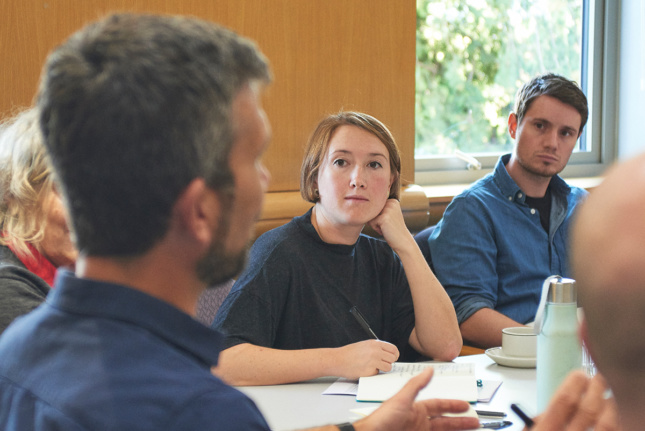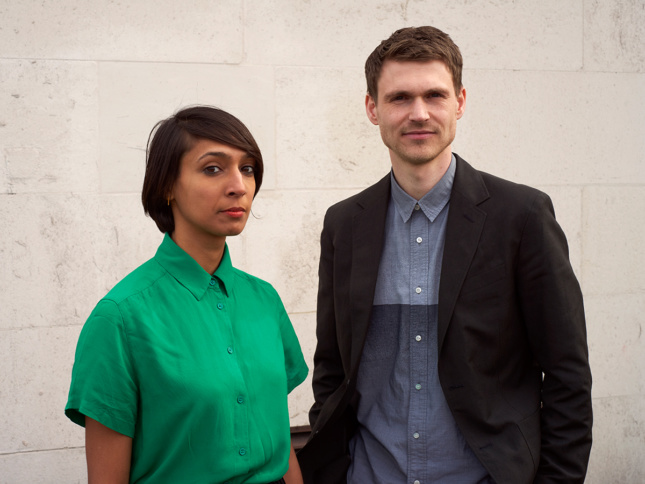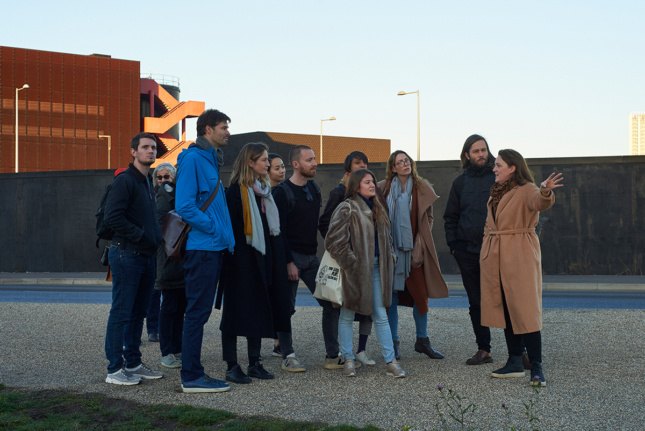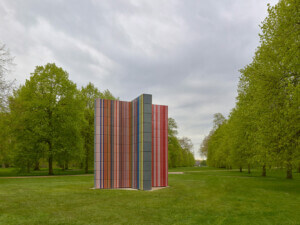“Attention: The fire alarm system is about to be tested. You do not have to leave the building. When all testing is complete, you will hear a further message.”
In the local council buildings in Greater London, the fire alarms are tested every Friday at 3 p.m. The seventeen associates of the independent nonprofit Public Practice have learned this by now, a few months into the nonprofit’s associates program. The participants are selected and placed at public planning offices in the region and meet up every two weeks, one hosting the rest of the group on a rotating schedule. These Fridays mean mutual exchange—of everything from recent research to the nuances of office culture.
This morning they arrived at a mildly postmodern conference room at Epping Forest District Council for tea and instant coffee. Semi-rural Epping sits at the northeastern end of London’s longest tube line, six public transit zones and a brisk walk from central London.

Ione Braddick, a young architect who was selected as an associate in the first Public Practice cohort a few months ago, has taken that route here every morning since. “Much of the work comes down to persuading people that a local council thinking about design is even a good thing,” she told AN.
This is also the main argument behind Public Practice. It works as a broker between organizations and people. On one end are local councils, planning authorities, transportation agencies, regional actors, and publicly owned development companies, and on the other are a new generation of designers looking to work in public planning. The first cohort of seventeen associates was picked and placed in new, strategic roles in April 2018. After a year, the hope is that they have gathered unique experiences, and also have built collective knowledge and networks between planning institutions.
When Public Practice was founded around a year ago by Pooja Agrawal and Finn Williams, it was on a basis of a series of clear observations: Four decades ago, 49 percent of all architects in the U.K. worked in the public sector. Today, only 0.7 percent do. Since the financial crash in 2008, local budgets for planning and development have dwindled. Planning authorities are struggling to stay relevant counterparts to strictly commercial interests. Nearly half of them have no in-house design capacity at all. Epping Forest was one such authority, until Braddick was placed here as a pioneer for the yearlong program.
Some of Braddick’s new Epping workmates have joined in around the table. Veneered walls and a lavender carpet frame the conference room window, which overlooks the far end of High Street, with a Tesco Superstore, a gas station, an Indian restaurant squeezed between coffee franchises, and a gothic revival church farther down. One block away, terraced-houses line private cul-de-sacs and at the horizon sit a dozen golf courses and a royal forest.
Much of what is happening here since Braddick arrived is happening for the first time. “You realize one of the things we architects are worst at is explaining why design is important,” she said.
Braddick used to work at a small architecture firm and enjoyed it. She led housing schemes from sketch to the construction site, instructed on the placement of bricks and the depth of mortar joints. But she found herself thinking: “Of all the things in architecture, buildings were maybe the one I was least interested in.”
She was more drawn to the ways people use the city and its structures. At her new workplace in Epping Forest’s public sector, she leads the council’s new “Implementation Team,” negotiating and reviewing larger projects, which in Epping’s case means 50 units or more. Plans for the expansion of Harlow and Gilston Garden Town are now on her table. “It’s like jumping into an entirely new career. Not only, as with any new job, trying to learn to use the printers and who everyone is and what everyone’s name is. You’re also trying to learn about whole democratic processes, decision-making and get a strategic understanding of an area that you, quite often, don’t know very well.”

Public Practice’s cofounders Agrawal and Williams, who share a background at reputable architecture schools and award-winning offices, themselves left the private sector to work for local authorities a few years ago. They would like to see more architects follow suit. And, more importantly, they have noticed that the British public sector struggles to attract—and maintain—the competence and knowledge that urban planning requires.
They thought they would have to work very hard to get local councils on board, but they have already received more inquiries than they can handle from all over the country.
To the planning and development industry, Public Practice offers a resource pool that the field could not otherwise reach and at a lower cost than the go-to temporary consultants. For the associates, the program offers a prestigious and hands-on role with a huge potential impact alongside a tight-knit community of like-minded colleagues. The Public Practice cohort meets regularly and spends a tenth of their time on common research and development. The project is supported financially by regional and national actors, private as well as public.
That the associates are placed in a wide spectrum of contexts, from Epping to the City of London and everything in between, is part of the idea. It is also a precondition for the exchange that everyone can visit each other without spending half a day traveling. Public Practice is looking to branch off to other regions with enough critical mass but, for the first cohort, London’s outer ring road is more or less the limit.

For Ei-Lyn Chia, another associate in the cohort, the London metropolitan region is also as far as her design work stretches. She used to do strategic planning with a private firm working on schemes which, she points out, ended up on a shelf. “I wanted to get things done. That’s why I applied here,” she said.
She is now getting used to the view from City Hall’s glass cocoon by the Thames. Her morning commute goes to Greater London Authority (GLA), run by Mayor Sadiq Khan. Braddick jokingly describes where Chia works as “the brain of London.” Chia agrees that the job deals with the city on a macro scale, but added: “Local councils are the real experts, who really understand local conditions. But ideas have to be carried through policy level and political decisions and Braddick fills in, urging for design skills to be present at every stage of planning, also, when projects are proposed, procured, reviewed, executed. That is not the case today.”
Along with two other Public Practice associates, Chia spends her research days exploring how industrial intensification can coexist with things like offices and housing. “Since the topics you work within the public sector are so multifaceted, it allows you to reach out to people in different disciplines, without it being weird,” she said, adding, “We’re allowing conversations to happen between people who wouldn’t otherwise have spoken to each other.”
That also applies to dialogues within, and between, the public sector’s different actors. One of the advantages of Public Practice, they have realized, is that seventeen people from different authorities regularly get together in the same room. It is a rare thing.
Most of the roles in which the associates have been placed are also positioned in between two different departments of an organization—which is intentional, said Chia. “With one foot in each door, that person, in effect, allows teams to transfer information in new ways.

Most of the associates have an architecture background and are at the start of their careers, with a stray example of one with 25 years of experience in local planning. Some have expertise in strategic planning, others in digital infrastructure or placemaking and public relations. What they all have in common is that they were drawn to the Public Practice model and, in tough competition with ten times as many applicants, have been placed where they can contribute the most during a year.
In a similar way, the organizations they now work for also applied to be part of the network. It is not a matter of just filling vacancies. Epping Forest and the GLA both had to present a case for a new role that they saw a strategic need for and were willing to offer resources for. On an intense day last spring, two hundred applicant architects and almost forty aspiring partner organizations gathered for workshops, talks, and interviews. According to Agrawal and Williams, it is this rigorous selection and matching process that is the key to the initiative actually working. Almost all 32 London municipalities say they need more urban design and planning expertise on the payroll, but have difficulties recruiting them. That is the gap that Public Practice is aiming to address. And what they are looking for in the applications, apart from talent and training, is humility, and the capacity to listen and to learn.
“Attention: All testing and engineering work on the fire alarm system is now complete. We apologize for any inconvenience caused.”
“I’m hoping to stay,” Braddick said, knowing what she would like to get out of her one-year placement. To see what she can contribute takes more than twelve months. And she hopes Epping Forest District Council sees the value in making a role like hers permanent. People around her are already talking about how things are designed, not just about parking quotas, profitability, and unit ratios. “‘Does it have a sense of place?’ people would ask, out of habit,” she said. “Well yeah, somewhere really shit can have a sense of place—but we want it to be a good place, don’t we?” Already trying to define what “good” is, is a successful start, she argues, and worth the effort.
Two weeks later, someone else will have the group visiting them at their workplace. The participants say it is thanks to the Friday meet-ups with their Public Practice colleagues that they had a smooth transition to a new working environment. When they see each other, they exchange new knowledge and concrete tips, but also share their experiences open heartedly. “Sometimes it’s all about leaning against someone and going, ‘Ah, what a week…I need a drink!’” Braddick and Chia said, “and the next time, it’s, ‘Something happened—it’s amazing!’”
A new cohort of Public Practice Associates will be starting placements in April 2019 in London, the South East, and the East of England. In the near future, the model is set to be expanded to other UK regions—perhaps also abroad.
This is a translation of an article previously published in Arkitekten, the news magazine of Architects Sweden.











